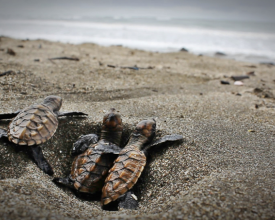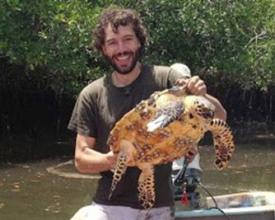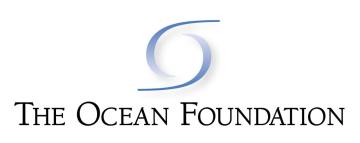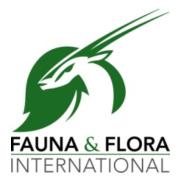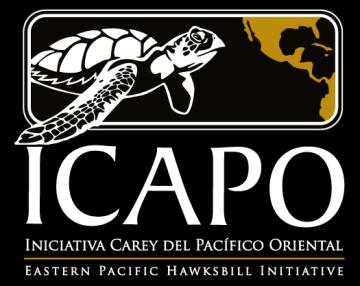
Protecting hawksbill sea turtle eggs using community incentive programs
Full Solution
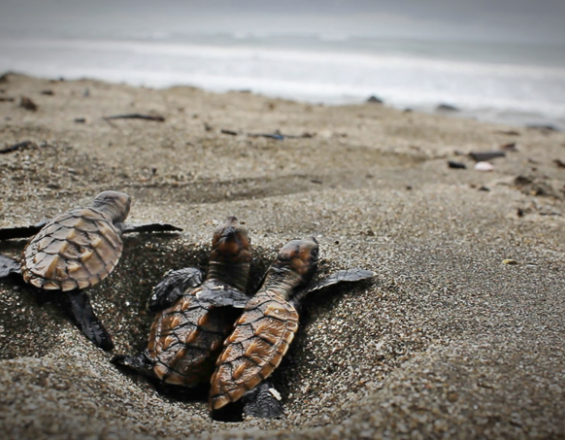
Young hawksbill turtles on the beach.
Eastern Pacific Hawksbill Initiative (ICAPO)
The Eastern Pacific Hawksbill Initiative (ICAPO) promotes the recovery of critically endangered hawksbill turtles in the eastern Pacific Ocean, which is considered one of the world's most endangered sea turtle populations. ICAPO has achieved unprecedented results (e.g., >98% nest protection and strong community support) at the primary hawksbill nesting grounds in El Salvador and Nicaragua through implementation of an innovative incentive program that rewards locals for protecting hawksbills.
Last update: 09 Nov 2021
13524 Views
Context
Challenges addressed
Unsustainable harvest (poaching) of critically endangered hawksbill sea turtle eggs.
• 80% population decline of hawksbill turtles in the last century.
• Only 400-600 adult female hawksbills surviving in the eastern Pacific Ocean.
• Lack of education and awareness about the endangered status of hawksbill turtles.
• Insufficient conservation and protection policy for hawksbill and other sea turtles.
• Impoverished conditions of coastal communities that rely on hawksbill resources.
Location
Hawksbill nesting sites in El Salvador and Nicaragua (Eastern Pacific)
Central America
South America
North America
Process
Summary of the process
ICAPO sees the conservation and protection of the hawksbill turtle nesting grounds in the Pacific as essential for the restoration of the species. Working with local inhabitants to collect data on nesting turtles and hatchlings improves the science we need to help this species. Once turtles make it out into the wild the fight for survival is not over. We monitor them at various stages of their life to increase our understanding and establish effective ways to protect them. That is why ICAPO works with local fisherman to implement strategies with alternative gear to reduce sea turtle bycatch. To further the likelihood of survival and population growth, we collaborate with several stakeholders to establish and enforce marine turtle protected habitats. We find and identify new habitats for hawksbill turtles to increase our outreach and effectiveness. Throughout all of this we facilitate tourism to conservation areas to increase awareness, education and support of this special species.
We follow these special turtles from beginning to end, increasing our understanding of them in order to more effectively help and protect them.
Building Blocks
Nesting Beach Conservation
Protecting hawksbill nests from poaching and other elements and employing local inhabitants and staff to collect data on nesting female turtles, hatchlings, and nesting performance. This improves the understanding of hawksbill biology and life-history and maximizes the number of eggs that result in hatchlings to increase the overall hawksbill turtle population.
Enabling factors
• Increasing efforts by conservation community to protect and restore critically endangered species populations worldwide.
• Demand for non-consumptive alternative sources of livelihood.
Lesson learned
• Direct payments for hawksbill egg protection create socio-economic benefits and encourage “reciprocal wellbeing” between local residents and nesting hawksbills.
• Importance of protecting coastal vegetation located within 200 meters of high tide mark for hawksbill nesting habitat.
Fisheries Bycatch Research/Reduction
Working with local fishermen through onboard fisheries observations and data collection at fishing ports of both turtle and non-turtle bycatch leads to knowledge of fishery dynamics and trends to seek alternative, sustainable fishing gear.
Enabling factors
• Increasing emphasis on ecotourism and preserving charismatic species.
• Economic value of tourism discourages unsustainable fishery practices.
Lesson learned
• Importance of eliminating irresponsible and illegal fishing practices, particularly blast fishing.
Policy Advocacy & Protected Area Management
Improvement and restoration of marine turtle habitats requires changes in laws and policies. Direct collaborative work with government institutions, non-profit organizations, and community members improves management and performance of protected areas, improves and restores habitats, provides greater benefits to marine turtles, and advances the natural habitats on which marine turtles depend.
Enabling factors
• Increasing efforts/funding by international organizations (including U.S. Fish and Wildlife Service and National Fish and Wildlife Foundation) to support endangered species conservation in developing nations.
Lesson learned
• Ambitious proposals that depend on co-leadership from government fisheries science agencies are prone to political disruption.
Importance of developing legislation that effectively regulates coastal development so it does not negatively impact nesting and juvenile hawksbill behavior.
In-Water Monitoring
Consistent use of tangle-nets, visual surveys, and hand captures provide valuable insights to hawksbill turtle biology, life history, residency times, growth rates, and dietary requirements of hawksbill turtles, as well as connectivity between nesting and foraging areas.
Enabling factors
• Ability to work with local partners to secure transportation for cruises.
• Advanced geo-positioning technology and field scientific equipment has enabled more sophisticated research.
Lesson learned
• Challenges associated with reconciling U.S. organizational policies regarding accounting procedures and insurance requirements with on-the-ground logistics and the provision of services to facilitate in-water monitoring.
Exploratory Habitat Investigations
Identifying new and important habitats for hawksbill turtles is vital to restoring their population. Visiting coastal communities and fishing ports to conduct interview surveys with local inhabitants and glean information on potentially important sites for hawksbills and conducting opportunistic in-water and beach monitoring leads to the discovery of important habitats.
Enabling factors
• Increased community buy-in to hawksbill conservation for economic and social reasons has facilitated cooperative relationships with local people that result in valuable data.
Lesson learned
• Hawksbills depend on highly vegetated coastlines for nesting.
• Mangroves provide critical habitat for hawksbills and can lead to declining populations if destroyed or fragmented.
Eco-Tourism, Outreach, and Education
Facilitating tourism to conservation areas provides alternative sources of income to local community members by increasing tours and providing room and board to tourists and travel representatives. Also, increased tourism reduces extraction and/or unsustainable use of natural resources, including turtles and their habitats. This raises awareness and provides education on hawksbill turtles, oceans, and general environmental stewardship.
Enabling factors
• Growing voluntourism sector, increasing market for outcome-oriented ecotourism.
Lesson learned
• Importance of international marketing to recruit volunteers, increase project’s exposure, and ultimately raise more funds to expand work.
• Community festivals are an effective approach to raising awareness and cultivating youth stewardship.
Impacts
• Ecological: New hope for the species. Previously though to be extinct along the Pacific coast of America, ICAPO's work has led to the discovery of several important nesting areas, as well as the identification of numerous foraging hotspots. Monitoring and conservation projects have been established at the most critical sites.
• Social and economic: New livelihood opportunities for community members. Project teams educate and provide job opportunities for local egg collectors, converting them from hawksbill poachers to protectors.
• Social and political: New policies and strategies. ICAPO researcher and findings are published in peer-reviewed literature and integrated into national and international hawksbill conservation Management strategies.
Beneficiaries
Hawksbill turtles, local community members, fishermen, tourists, volunteers, governments.
Story
David Melero, ICAPO's Alternative Livelihoods Program Director: “Our egg incentive approach contrasts to that of most sea turtle conservation programs, which have historically attempted to push out local poachers/community members, leaving them embittered and with limited options to generate incomes, a scenario which often leads to major conflict in subsequent years. Our innovative, inclusive approach is largely responsible for our unprecedented conservation successes, which includes a reduction in egg poaching from 100% to almost zero! The incentive program has also played a fundamental role in solidifying the extremely strong support the project receives from community members... they love this project."
Connect with contributors
Other contributors
Ben Scheelk
The Ocean Foundation
Alexander Gaos
Eastern Pacific Hawksbill Initiative (ICAPO)
Mark J. Spalding
The Ocean Foundation
